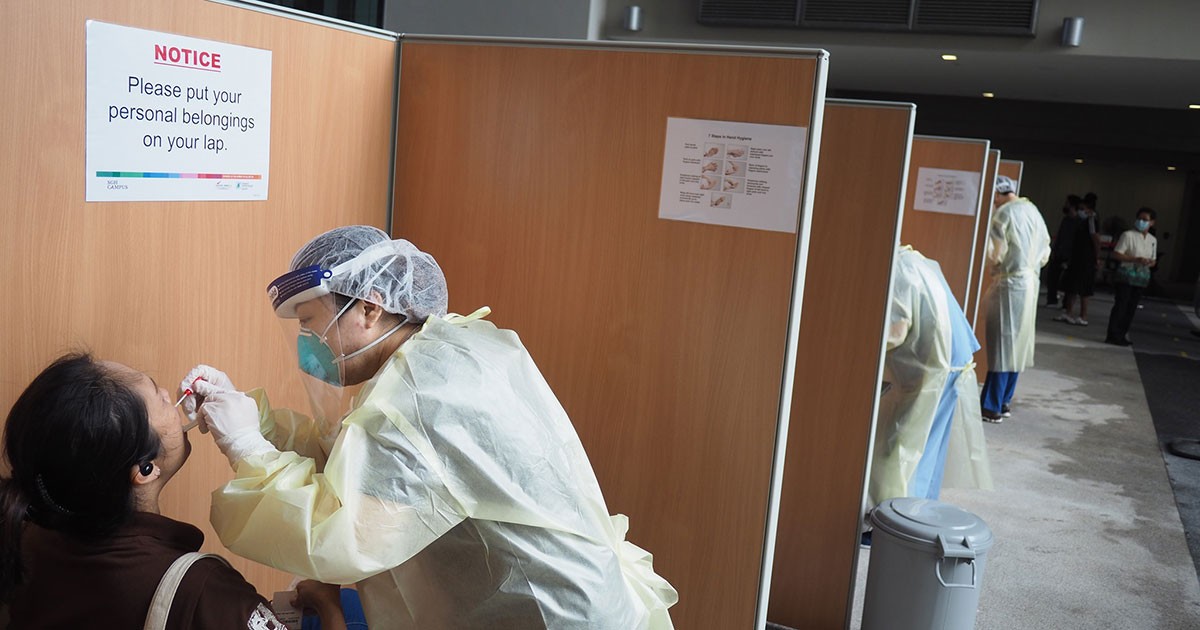Follow us on Telegram for the latest updates: https://t.me/mothershipsg
Healthcare workers in Singapore are very tired and burned out after close to two years of Covid-19.
A peek behind the hospital curtain was provided by CNA, which interviewed a number of healthcare workers at the frontlines who were quoted anonymously because none of them were authorised to speak to the media.
With the recent spike in Covid-19 cases, where between 2,000 and 4,000 positive cases are reported in a single day over the past two weeks, waiting times and bed occupancy rates at hospitals have surged, pushing those working to care for the sick to the edge.
Adding to the urgency of keeping up with these cases, there appears to be no respite as the pandemic does not have an end in sight, healthcare workers interviewed said.
One junior doctor, who works at a public hospital in Singapore, told CNA: “I haven’t seen the daylight in ages.”
This is what has been happening on the ground.
No day off in three weeks
A woman doctor at a local hospital said she has not had a day off in nearly three weeks.
Healthcare workers revealed to CNA that all applications for overseas travel have also been suspended, which led to unhappiness among staff.
The move was overseen by MOH Holdings, the holding company of Singapore's public healthcare clusters National University Health System, National Healthcare Group and Singapore Health Services.
Crunch in manpower
The force of the manpower crunch was felt when things went from okay to worse.
One public hospital doctor claimed his hospital management was unwilling to provide more manpower until things became more serious recently.
No reason was cited for this resistance.
But what is clear is that there are those who are shunning the nursing vocation.
In 2020, CNA reported that the number of nurses in Singapore fell for the first time in at least 15 years.
There were 42,096 nurses in 2020, 572 fewer than in 2019.
MOH has said it will reach out to and bring in those registered with the Singapore Healthcare Corps, as well as nurses registered with the nursing board but are not in active practice.
So far, about 900 people have stepped forward in response.
Tan Tock Seng Hospital has also started a new para-nursing initiative in September to support nurses to free them up to do clinical care.
About 150 non-nursing employees will be trained to carry out essential, low-risk nursing tasks.
But this might not be enough as one doctor interviewed said those currently in the vocation are stretched as they need to be trained in ICU and HDU (high dependency unit) to handle these patients, and there are not many of those around.
Whiplash from constantly changing rules
Changes in rules and procedures in hospitals have also created frustration among patients, doctors told CNA.
In some cases, patients and their family members get agitated, as what was the norm on one day is no longer carried out on another day.
The woman doctor said she was shouted at and verbally abused on several occasions.
Worried about infection
The woman doctor also revealed her constant worry that healthcare workers might get infected and pass it on to others.
She said she was exposed thrice to a Covid-19-positive patient without knowing it.
To mitigate the risk, she moved out of her home nearly 10 months ago to minimise the risk of exposing her family to Covid-19.
Constantly making space for new patients
The unnamed junior doctor said his hospital has seen patient admissions double in one week.
Patients were reportedly admitted "non-stop".
Two or even three patients are now being put in a single room, he said, when it is supposed to be one patient per room.
At times, more than 10 patients come in at one go.
Covid-19 cases more sickly as less sick not warded
The junior doctor revealed that the conditions in hospitals have also changed due to the change in protocol.
With the less sick staying home to recover, those who get admitted are sicker and cannot self-isolate or be left at isolation facilities.
The doctor said that as a result of this shift, if there were just 2 per cent of patients who require hospital care now, the hospitals will be flooded with serious cases, and "that’s still a lot", he said.
These patients that end up in hospital are often very old with Covid-19 and have much more severe illnesses, with a lot of medical problems and multiple issues on top of the virus.
These patients, he said, are "very complicated cases".
Official figures by MOH
In the second week of October, MOH said the occupancy for Covid-19 isolation beds increased from 62 per cent in July to 85 per cent over the past three months.
Covid-19 patients seeking medical attention at emergency departments over the past three months have increased eight-fold.
Singapore now has around 2,500 Covid-19 beds, up from 900.
Of these, about 170 are intensive care beds, and another 100 can be converted into ICU beds if necessary, MOH added.
Nine Covid-19 treatment facilities with a capacity of 3,700 beds will also be set up soon for higher-risk patients who do not need to be hospitalised.
Follow and listen to our podcast here
Top photo via
If you like what you read, follow us on Facebook, Instagram, Twitter and Telegram to get the latest updates.
